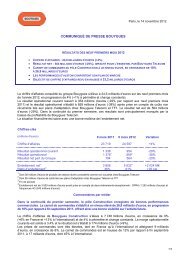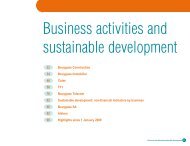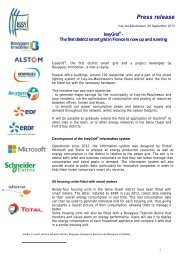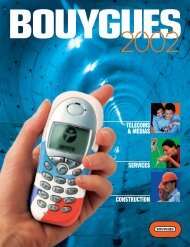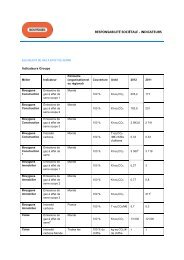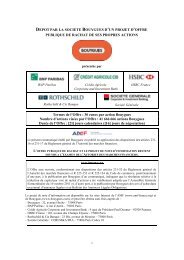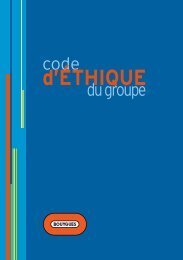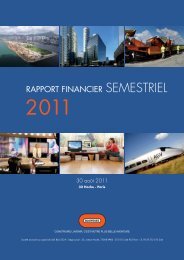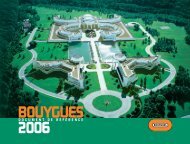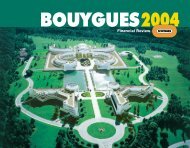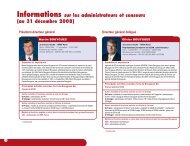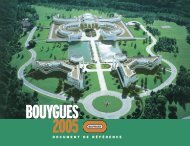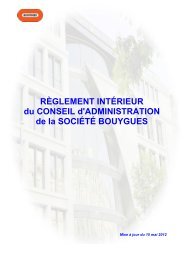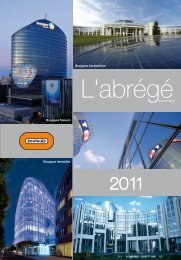A N N U A L R E P O R T - Bouygues
A N N U A L R E P O R T - Bouygues
A N N U A L R E P O R T - Bouygues
Create successful ePaper yourself
Turn your PDF publications into a flip-book with our unique Google optimized e-Paper software.
■ Leases:<br />
Items of property, plant and equipment held<br />
under leases whereby the <strong>Bouygues</strong> Group retains<br />
substantially all the risks and rewards of ownership<br />
are recognised as assets in the balance<br />
sheet. Leases are classified as finance leases or<br />
operating leases in accordance with the criteria<br />
specified in IAS 17. Prior to the first-time adoption<br />
of IFRS, leased assets were only recognised in the<br />
balance sheet if the lease qualified as a créditbail<br />
transaction under French GAAP.<br />
Assets held under finance leases are recognised<br />
in the balance sheet in “Property, plant and<br />
equipment” at the lower of fair value or the<br />
present value of the minimum lease payments,<br />
less accumulated depreciation and impairment<br />
losses. They are depreciated over their estimated<br />
useful lives. The lease obligation is recognised as<br />
a liability under “Debt” in the balance sheet.<br />
Obligations under operating leases are disclosed<br />
in off balance sheet commitments.<br />
2.6.2. Intangible assets<br />
IAS 38 defines an intangible asset as an identifiable<br />
non-monetary asset without physical<br />
substance, which may be:<br />
- separable, i.e. capable of being independently<br />
sold, transferred, licensed, rented or exchanged;<br />
or<br />
- derived from contractual or other legal rights,<br />
whether separable or not.<br />
Intangible assets with finite useful lives are<br />
depreciable. Intangible assets with indefinite useful<br />
lives are not depreciable, but are subject to an<br />
impairment test at each balance sheet date.<br />
They include:<br />
• Development expenses:<br />
- in accordance with IFRS, incorporation and<br />
research expenses are expensed as incurred.<br />
ed to generate future economic benefits and<br />
their cost can be reliably measured.<br />
• Concessions, patents and similar rights:<br />
These include the following assets held by<br />
<strong>Bouygues</strong> Telecom:<br />
Type of asset<br />
GSM frequency<br />
costs<br />
Amortisation<br />
method<br />
straight line<br />
Period<br />
12 years<br />
UMTS licence straight line<br />
(1)<br />
IT system<br />
software and<br />
developments<br />
straight line<br />
4 years<br />
Office software straight line 4 years<br />
(1) The amortisation period for the UMTS licence will match its<br />
useful life. Since the high-speed network opened on 26 May<br />
2005, <strong>Bouygues</strong> Telecom has been amortising its UMTS licence<br />
over a period of 17.5 years.<br />
• UMTS licence:<br />
The fee for the UMTS licence, awarded for a 20-<br />
year period, comprises:<br />
• a fixed component of €619.2 million, recognised<br />
as an intangible asset on the date the licence<br />
was awarded (12 December 2002);<br />
• a variable component, calculated at 1% of sales<br />
generated by the operation of the third-generation<br />
mobile network, which is recognised in the<br />
income statement for the period with effect<br />
from the opening of the UMTS network.<br />
2. 6. 3. Other intangible assets<br />
Other intangible assets recognised by the Group<br />
include leasehold rights and broadcasting rights<br />
(TF1).<br />
Intangible assets with no legal protection have<br />
been reclassified as goodwill under IFRS.<br />
■ TF1 broadcasting rights:<br />
This item includes shares in films and programmes<br />
co-produced by TF1 Films Production,<br />
TF1-Video, Glem and Téléma; distribution and<br />
trading rights owned by TF1 International TCM<br />
DA, TF1 Entreprises and CIBY DA; and music rights<br />
owned by Une Musique and Baxter.<br />
Broadcasting rights are accounted for at historical<br />
cost. Dates of initial recognition and amortisation<br />
methods are as follows:<br />
Initial recognition<br />
End of shooting<br />
Censors’ certificate<br />
Signature of contract<br />
Co-production shares<br />
in line with revenues<br />
3 years<br />
straight line<br />
For films co-produced by TF1 Films Production<br />
and Téléma, the Group uses whichever method<br />
enables the film to be amortised as quickly as<br />
possible. Consequently, the method used may<br />
differ from film to film.<br />
In accordance with IAS 36, an impairment loss<br />
is recognised on a line by line basis where estimated<br />
future revenues do not cover the carrying<br />
amount of the asset.<br />
Amortisation method<br />
Broadcasting rights<br />
Distribution / Trading<br />
3 years straight line, or<br />
in line with revenues<br />
(5 years for trading)<br />
Music rights<br />
2 years<br />
75% in year 1<br />
25% in year 2<br />
- development expenses are capitalised if the<br />
relevant criteria are met, i.e. if they are expect-<br />
CONSOLIDATED FINANCIAL STATEMENTS<br />
161



